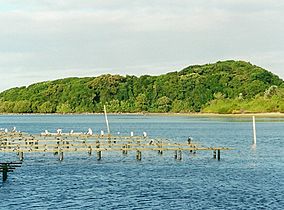Littoral Rainforests of New South Wales facts for kids
Quick facts for kids Littoral Rainforests of New South Wales |
|
|---|---|

Littoral Rainforest at Brunswick Heads Nature Reserve, Australia
|
|
| Governing body | NSW National Parks and Wildlife Service |
The Littoral Rainforests of New South Wales are special forests found along the coast in eastern Australia. They are made up of small, separate areas and are in danger of disappearing. A lot of these seaside forests have been destroyed by mining, building hotels for tourists, or new homes. Because of this, they could disappear forever soon.
Most of these forest areas (90% of them!) are smaller than 10 hectares (about 25 acres). These special coastal rainforests make up only a tiny part (less than 1%) of all the rainforests in New South Wales. You can find these rainforests along the coast from North Queensland all the way down to Victoria, and even on some islands. Only a small part of them are in New South Wales.
Contents
What are Littoral Rainforests?
These forests usually grow very close to the ocean, within 2 kilometers (about 1.2 miles) of the coastline. In New South Wales, you can find them from Mimosa Rocks National Park in the south up to the border with Queensland. The trees grow so close together that their leaves form a thick roof, blocking about 70% of the sunlight.
In places protected from strong winds, the trees can grow as tall as 30 meters (about 100 feet)! However, they are more often seen between 5 to 15 meters (16 to 50 feet) tall. These coastal forests are often thought of as a type of sub-tropical rainforest. This is because only a few rainforest plants grow only in these seaside spots.
Amazing Plants of the Littoral Rainforest
The plants in these rainforests often have thick, leathery leaves. This helps protect them from strong sea winds and salty air. Climbing vines are also very common here. Many tree species belong to plant families like Myrtaceae, Lauraceae, Sapindaceae, Euphorbiaceae, Moraceae, and Rutaceae.
Some plants that can handle salt, like Plum Pine, Tuckeroo, Red Fruited Olive Plum, Black Apple, Mock Olive, and Bolwarra, are often found here. Some very rare plants, like the Coast Fontainea and the Scented Acronychia, are also found in these forests. You won't see as many ferns here as in other nearby rainforests. Sometimes, trees that are not usually found in rainforests, like the Coast Banksia (Banksia integrifolia) and Bangalay (Eucalyptus botryoides), can also grow in these areas.
How the Environment Shapes the Rainforest
These rainforests can grow on beach sand, on rocky coastal cliffs, or on headlands that have rich volcanic minerals. The sea winds actually help the sandy soil by bringing in minerals like calcium, magnesium, potassium, and phosphorus. The air is usually very humid, and the weather is mild. Temperatures here are warmer than further inland.
These areas usually get more than one meter (about 40 inches) of rain each year. The salty winds from the ocean often make the top of the forest canopy (the leafy roof) very even and dense. However, unwanted plants (weeds) are a big problem for the remaining areas of these forests. Also, biting insects, ticks, thick plants, and many reptiles live here.
Where to Find Littoral Rainforests
You can find examples of this special rainforest type in many places. Some southern spots include Mimosa Rocks National Park, Seven Mile Beach, Burning Palms, and Barrenjoey.
Further north, they are protected at places like Sea Acres National Park, Broken Head Nature Reserve, and Brunswick Heads Nature Reserve. The biggest littoral rainforest in NSW is at Iluka Nature Reserve. This reserve is part of the amazing Gondwana Rainforests of Australia, which is a World Heritage Site. It was first recognized in 1986 and added to the Australian National Heritage List in 2007.

